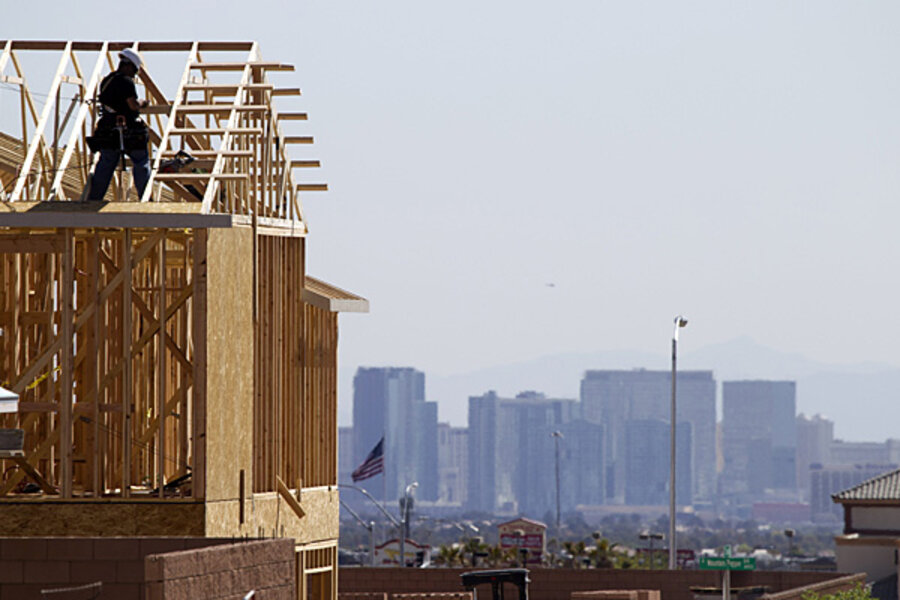Housing starts surge. How it's widening the wealth gap.
Loading...
At first glance, April’s housing starts numbers look like a lifeboat in a sea of underwhelming housing data that has flooded the past few months. But even in the most positive numbers, some analysts see possible trouble.
The pace of new US home construction hit a six-month high in April, with housing starts jumping 13.2 percent to an annualized pace of 1.07 million units, according to data released Friday by the US Commerce Department. Economists had expected starts to hit a 980,000 pace, after hitting 947,000 in March. Construction permits also edged up, indicating that building activity could accelerate in the near term.
Most of the surge came from the multifamily sector, a traditionally volatile category that grew 40 percent in April. “Normally, when this segment of starts surges such as this in a single month it backs off in the ensuing period,” Joshua Shapiro, chief US economist with MFR Inc. in New York, writes via e-mailed analysis. “With that said, it is possible that the harsh winter delayed some existing projects enough that new ones were pushed back and are only now emerging in clumps. If that is the case, we could see an elevated level of multi-family starts for a while until the backlog clears.”
After being a bright spot in the early parts of the economic recovery, the housing market started to slow late last summer as a result of rising mortgage rates and worries about the Federal Reserve slowing its monetary stimulus activities. A spate of underwhelming data, including a slowdown in home sales in the face of quickly climbing prices, characterized early 2014, and economic experts began to worry that slow growth in the sector could derail the recovery overall.
In early May remarks to Congress’ Joint Economic Committee, Federal Reserve Chair Janet Yellen was generally upbeat about the direction of the economy but warned, "One cautionary note, though, is that readings on housing activity – a sector that has been recovering since 2011 – have remained disappointing so far this year and will bear watching … the recent flattening out in housing activity could prove more protracted than currently expected rather than resuming its earlier pace of recovery."
Ms. Yellen wasn’t warning of a “housing doomsday,” notes Stephanie Karol, an economist with IHS Global Insight in Lexington, Mass., in a telephone interview. “She meant our expectations need to be downgraded. If you read the forecast of the Fed and the central bankers, most of them have been anticipating a growth pickup later this year, but hinging on a recovery in housing. Something needed to kick in to have things [really improve], and everyone expected housing to play this role. Her concern is we may see another year of disappointing growth because housing is not kicking in."
Some feel that Friday's report might ease those worries somewhat. A severe winter badly hampered construction early this year, and it may bounce back as builders work through a backlog of delayed projects. Housing starts tend to be a reliable indicator of future growth, at least in the short term. “Altogether, today’s report on US housing starts should help to assuage FOMC concerns that housing activity was flattening out as opposed to gradually recovering after successive adverse shocks from higher mortgage rates last year and adverse weather more recently,” Michael Gapen, an analyst with Barclays Research, writes in an e-mail.
But Ms. Karol thinks that the actual breakdown of the numbers could be a sign of larger long-term problems. Most of the growth in housing starts in recent months has been driven by the multifamily sector, mostly buildings with rental units. Single-family starts only picked up 0.8 percent in April; permits for that segment inched up 0.3 percent. Tighter lending standards, high house prices, and a jobs recovery characterized largely by low-wage and part-time jobs gains mean fewer people are in a position to buy homes, and demand for rentals is high. Families are spending more of their incomes on rent: monthly rent prices climbed 3.2 percent in 2013, to $1,083 on average.
Also, “more single-income households are supporting more people,” Karol points out. “That’s holding back the single family market and feeding the multifamily market.”
As a result, taking on a mortgage isn’t feasible for many families, and that can be damaging to long-term wealth-building. Renting long-term is “locking yourself out of one of the best ways to build wealth in this country,” Karol says For some people it’s safer, but on the other hand, in terms of greater economic inequality, if we have a class of owners and growing class of renters, It becomes harder for that class of people to afford the things that make their descendants upwardly mobile.”
The trend will only reverse itself, she says, if full-time jobs and income grow stronger.








